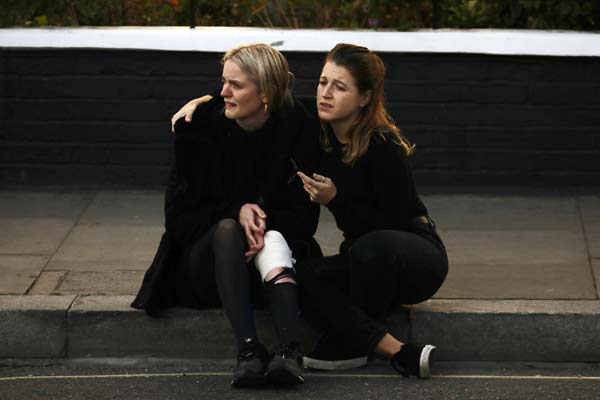The terror of not knowing...
- By Earl Bousquet
 0 Comment(s)
0 Comment(s) Print
Print E-mail China.org.cn, October 7, 2017
E-mail China.org.cn, October 7, 2017
|
|
|
An injured woman reacts outside Parsons Green tube station in London, Britain September 15, 2017. [Photo/China Daily] |
The recent explosion in a London underground railway station sparked off the usual reaction of focusing on "Who did it?" instead of "Why?"
As usual, the police and investigators found themselves running into some brick walls along the way.
However, the ages of the suspects detained and then released revealed an interesting constant in recent similar investigations across Europe: the growing number of early teens involved in some way.
Much of the post-9/11 analysis has focused on the period since New York's iconic Twin Towers were attacked, killing thousands and causing untold harm.
Attention since then has been on the growth of armed groups developing around the world in the shadows of Al Qaeda, visiting terror on populations in Africa, Asia, and the Arab World -- and now, increasingly, in Europe and the North America.
The growth and seeming demise of the Islamic State of Iraq and Syria (ISIS) and its "Caliphate" has been characterized differently by various analysts.
However, it is foolhardy to believe that any single or even series of victories gained on the battlefield against ISIS or any of its affiliates elsewhere will rid the world of the problem.
Just as the Taliban outlived the U.S. intervention in Afghanistan, ISIS is also destined to live way beyond its current battlefield life, particularly in the hearts and minds of thousands of trained foreign fighters who helped sow and spread terror in captured territories.
Many of the foreign fighters died on the battlefield, leaving behind expectant wives and fatherless, but many others have also long since returned home, particularly in Asia, Europe and nearby Arab states.
And while these returning fighters have traceable identities, the invisible terror lies in the untold thousands of particularly young IT-minded citizens of many countries recruited online by attractive ISIS propaganda, who remain as embedded Soldiers of the Caliphate in civilian society, only awaiting the call to act.
Tens of thousands of young "terror suspects" are on police and intelligence radars in Britain, France, Germany and other European states, as well as in the U.S. and Canada. However, those doing the watching admit there are just too many to monitor collectively, continuously and indefinitely.
The knowledge that there are so many unsuspected others off the radar is a terrifying thought.
Today, the theaters of terror have not moved as much as they have extended to new locations around the globe, as far as the Internet can reach.
No corner of the world is immune to the reach of those trained in terror tactics or committed to continuing the fight for their lost cause in other ways and places.
The real war on terror is as much a Cyber one as it is a continuing battlefield endeavor.
And like every other case of its kind, it must start with a frontal and unified attack on the conditions that give rise to the human element on which the recruiters of soldiers for terror have so successfully depended, without disappointment.
Chief among these is the tendency of young people today to want to loudly and effectively register their revolt against those they hold responsible and wish to blame and punish for their feelings and experiences of social exclusion.
Unemployed and frustrated youth of any language, cultural background or national origin versed in today's increasingly sophisticated, but equally challenging IT-based computer war games will most likely gravitate to a job of putting those screen plays into real use, not excluding getting paid to kill in the name of something they believe in strong enough.
The U.S. is not excluded from this sinister act of recruiting young brains for war.
It has increased recruitment of tech-savvy American youth to pilot -- from a distance and by computer -- drones on killing missions thousands of miles away in Afghanistan and Pakistan.
Totally removed from the immediate scene of their action, the young pilots with weapons at their fingertips treat each explosive mission just as they would do any of their regular computerized war games at home -- as just another play of the day.
Those paid to kill in the name of country simply don't feel the bombs, see any blood or count the dead. But in most cases the awoken sleepers end up dead during their terror missions.
The solution is never easy. It includes a basket of measures aimed at continuously tackling the growing social problems that lead to the increasing collective disillusionment among youth and within the society.
The untold number of sleeper cells in Europe and North America do pose a continuing and unending threat, as they cannot ever all be identified, far less monitored.
The rapidly changing terror tactics, the increasing number of "teen soldiers" being recruited, the growing number of attacks and increasing numbers of victims, all confirm that it is both an illusion and a delusion to believe that the battle to protect societies from acts of terror will eventually prevail no matter what.
Until the causes and symptoms of societal displeasure are seriously, honestly and systematically tackled, the breeding grounds will continue to exist and produce today's young soldiers of fortune ready for recruitment for terror.
Earl Bousquet is a contributor to china.org.cn, editor-at-large of The Diplomatic Courier and author of an online regional newspaper column entitled Chronicles of a Chronic Caribbean Chronicler.
Opinion articles reflect the views of their authors, not necessarily those of China.org.cn.







Go to Forum >>0 Comment(s)